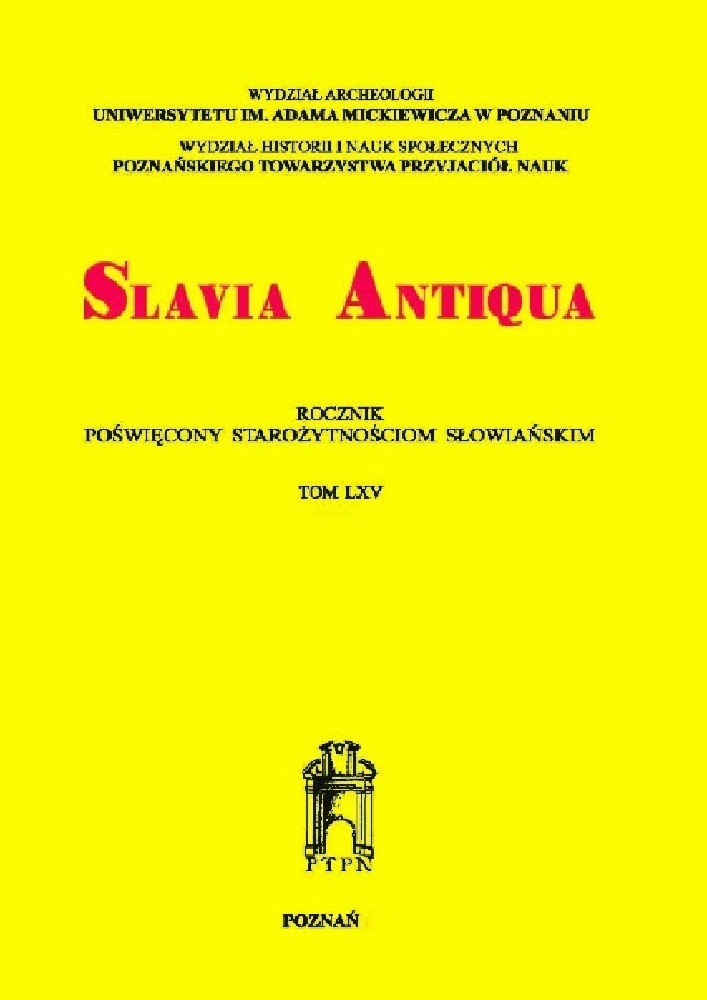Abstract
The elite cemetery in Bodzia (from the late 10th to the early 11th centuries) hosts the deceased of foreign and local origin who had a strong sense of ideological and ethno-cultural bonds. According to the results of the author’s latest research, a large tomb D162 played a pivotal role in the cemetery. It was originally built as a grave – a mausoleum with an entrance from the east. Over time, more graves with enclosures were added to the existing tomb on the eastern side, imitating architecture of a primary grave. The successive burials in which remains of foreigners were identified represented the structural first degree elements of the cemetery. In line with the results of isotopic labelling, the group of people buried in this row is associated with newcomers from the Baltic (Scandinavian) zone. In search of the sources of the idea and, further on, the model of the cemetery, attention was directed at the symbols and the structural elements of royal courts and rural aristocratic mansions, especially rectangular plots of land with enclosures as known from Denmark. In the light of newer research, the most symbolic representations include the topography and structural elements identified around the royal kurgans in Jelling.References
Bodzia… – Buko A. (red.), Bodzia. Elitarny cmentarz z początków państwa polskiego, Warszawa 2016.
Băcueț-Crișan D. 2015, Pagans or christians in the early mediaeval cemetery from zalău “valea răchişorii / pálvár”? in: S.A. Cociș, V.A. Lăzărescu, M. Gui, D.A. Deac eds, Ad finem imperii romani, studies in honour of Coriolan H. Opreanu, Cluj-Napoca, s. 71-83.
Bogdanowicz W., Grzybowski T., Buś. M.M. 2016, Analiza genetyczna wybranych grobów z cmentarza z Bodzi, w: Bodzia…, s. 437-445.
Bogucki M. 2016a, Szlaki handlowe środkowej i dolnej Wisły w X-XI w. w świetle danych archeologicznych, w: Bodzia…, s. 17-32.
Bogucki M. 2016b, Intercultural relations of the inhabitants of Polish territory in the 9th and 10th centuries, w: M. Trzeciecki (red.), The Past Societies. Polish Lands from the first evidence of human presence to the Early Middle Ages, , vol. V, 500–1000 AD, Warszawa, s. 223-276.
Buko A. 2016, Cmentarzysko w Bodzi w świetle wyników badań interdyscyplinarnych, w: Bodzia…, s. 489-507.
Buko A. Kara M. 2016, Chronologia cmentarza, w: Bodzia…., s. 446-452.
Buko A. (red.) 2015, Bodzia. A Late Viking- Age Cemetery in Central Poland, Leiden-Boston.
Buko A. 2016, Bodzia. Elitarny cmentarz z początków państwa polskiego, Warszawa.
Buko A., Kara M., Price D., Duczko W., Frei K, Sobkowiak-Tabaka I. 2013, A unique medieval cemetery from the 10th/11th century with chamber-like graves, „Archäologisches Korrespondenzblatt“, Jahrgang 43, Heft 3, s. 423-442.
Goslar T. 2016, Wyniki kalibrowanych datowań radiowęglowych prób z cmentarzyska w Bodzi wykonanych w Poznańskim Laboratorium Radiowęglowym metodą 14C AMS, w: Bodzia…, s. 453-454.
Gräslund A.S. 1980, Birka, IV: The Burial Customs. A study of the graves on Björkö, Stockholm.
Holst M.K. 2010, Inconstancy and stability –Large and small farmsteads in the village of Nørre Snede (Central Jutland) in the first millennium AD, “Siedlungs- und Küstenforschung im südlichen Nordseegebiet“, 33, Rahden/Westf., s. 155-179.
Holst M.K, Jessen D.M., Andersen S.W., Pedersen A. 2012, The Late Viking-Age Royal Constructions at Jelling, central Jutland, Denmark. Recent investigations and a suggestion for an interpretative revision, “Praehistorische Zeitschrift”, 82 (2), s. 474-504.
Jagodziński M.F. 2010, Truso. Między Weonodlandem a Witlandem, Elbląg.
Jessen M.D, Andersen S.W, Holst M.K, Jensen P. Pedersen A. 2011, Kongens gård i Jelling? – et nyt anlæg fra Harald Blåtands tid, P.K. Madsen, I. Wass eds., Nationalmuseets Arbejdsmark, s. 60-73.
Kara M. 2016a, Organizacja przestrzeni grzebalnej, rytuał i obrządek pogrzebowy, w: Bodzia…, s. 329-380.
Kara M. 2016b, Cmentarzysko w Bodzi w kontekście praktyk funeralnych ludności ziem polskich 2. połowy X-XI w., w: Bodzia…, s. 481-486.
Kowalska A.B. 2016, Skórzane elementy stroju w pochówkach na wczesnośredniowiecznym cmentarzysku w Bodzi, w: Bodzia…, s. 253-264.
Krogh K.J. 1983, The Royal Viking-Age Monyments at Jelling in the light of Recent Archaeological Excavations. A Preliminary Report, “Acta Archaeologica”, 53, s. 183-216.
Krąpiec M. 2016, Wyniki kalibrowanych datowań radiowęglowych prób z cmentarzyska w Bodzi wykonanych metodą konwencjonalną w Laboratorium Datowań Bezwzględnych w Cianowicach k. Krakowa, w: Bodzia…., s. 455-458.
Morawski W., Zaitz E. 1977, Wczesnośredniowieczne cmentarzysko szkieletowe w Krakowie na Zakrzówku, „Materiały Archeologiczne” 17, s. 53-169.
Pedersen A. 2014, Jelling in 10. Jahrhundert – Alte Thesen, neue Ergebnisse, in: Die Wikinger und Fränkische Reich. Identitäten zwischen Konfrontation und Annäherung, Hofmann P.H., Kamp H., Wemhoff M., eds., Padeborn, s. 275-295.
Podhorský J. Drnovský P. 2017, Raně středověké náhrobníky z Čech, „Archeologie ve středních Čechách”, 21, s. 373-407.
Price T.D., Frei K.M. 2016, Badania izotopowe pochówków z Bodzi, w: Bodzia…., s. 425- 436.
Sawicki T. 2016, Próba rekonstrukcji skrzyń trumiennych, w: Bodzia…, s. 381-406.
Sobkowiak-Tabaka I. 2016, Katalog grobów i ich wyposażenia (wersja skrócona), w: Bodzia…., s. 66-81.
Suchodolski S. 2016, Obol zmarłych, w: Bodzia, s. 285-304.
License
Copyright (c) 2018 Slavia Antiqua. Rocznik poświęcony starożytnościom słowiańskim

This work is licensed under a Creative Commons Attribution-NoDerivatives 4.0 International License.
